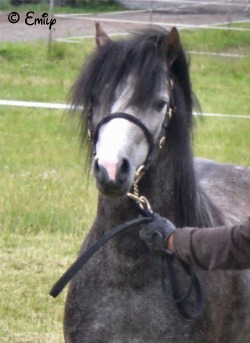The Welsh Mountain - Not just a pretty face

Bred in the mountains and wild regions of Wales for many generations, their acknowledged beauty does not mean they are merely a 'pretty toy' — centuries of 'survival of the fittest' has ensured the sound constitution, iron hard limbs and great intelligence which combined with the legendary Welsh temperament, makes the ideal child's pony of today. They can be seen ridden and driven all over the world — equally at home in the cold of Canada and Sweden or the heat of Africa and Australia.
The head of the Mountain Pony should be small, with neat pointed ears, big bold eyes and a wide forehead. The jaw should be clean cut, tapering to a small muzzle; the silhouette may be concave or 'dished' but never convex or too straight. The neck should be of good length and well carried with shoulders sloping back to a clearly defined wither. The limbs must be set square with good flat bone and round dense hooves. The tail set high and gaily carried.
The height should not exceed 12 h.h. (121.9 cms).
Source: WPCS - The Welsh Pony and Cob Society - www.wpcs.uk.com
General Character
Hardy, spirited and pony-like
Head
Small, clean-cut, well set on and tapering to the muzzle
Ears
Well-placed, small and pointed, well up on the head, proportionately close
Jaws and Throat
Clean and finely-cut, with ample room at the angle of the jaw
Shoulders
Long and sloping well back. Withers moderately fine, but not "knifey". The humerus upright so that the foreleg is not set in under the body
Back and Loins
Muscular, strong and well coupled
Ribs
Well sprung
Action
Action must be quick, free and straight from the shoulder, knees and hocks well flexed with straight and powerful leverage well under the body
Colour
Any colour, except piebald and skewbald
Eyes
Bold
Nostrils
Prominent and open
Jaws and Throat
Clean and finely-cut, with ample room at the angle of the jaw
Forelegs
Set square and true, and not tied in at the elbows. Long, strong forearm, well developed knee, short flat bone below knee, pasterns of proportionate slope and length, feet well-shaped and round, hoofs dense.
Girth
Deep
Hind Quarters
Hocks to be large, flat and clean with points prominent, to turn neither inwards nor outwards. The hind legs not to be too bent. The hock not to be set behind a line from the point of the quarter to the fetlock joint. Pasterns of proportionate slope and length. Feet well-shaped, hoofs dense.
